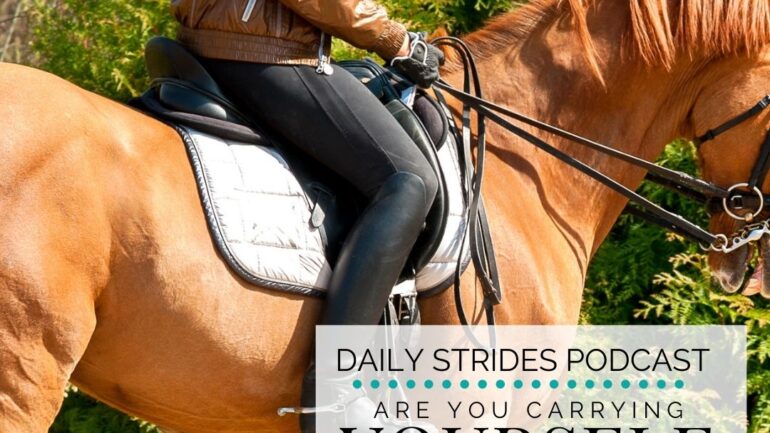Self-carriage is a pretty big topic when it comes to riding and riders in general. And it should be. It is an important aspect when it comes to training moving in the right direction. However – you knew there was a ‘however’ coming, right?!
Often we put the cart before the horse when it comes to self-carriage in riding. We focus on the horse’s self-carriage – or lack thereof. When, in reality, we should first focus on the rider’s ability to correctly carry themselves first.
Creating Space
The reason this is true is pretty obvious when you actually spend time looking at horses and their riders. In order for the horse to truly begin to embrace the concept of self-carriage in their training, there must be space available for them to move into.
In order for this to occur there needs to the necessary strength and engagement through the core of the body. And it is this ‘core engagement’ that is so often missing as riders work and train in the saddle with their horse.
Think Standing Not Sitting
One of the most simple ways to begin ‘testing’ this in your riding is to become aware. If you were to stand the arena, no horse underneath us, your core must engage. I say must, because if not, you will fall over. I say this because so many riders use ‘lack of core’ as an excuse for poor performance in the saddle.
The simple truth of the matter is that if you walked unaided to your horse to mount up, your basic core is pretty sufficient to begin carrying yourself in the saddle when you ride.
This brings me to the awareness of how it feels to ‘stand’ on your own two feet. This ‘standing’ feeling is different from when most people sit. Sitting encourages slouching and complete relaxation of the core muscles. This is what most riders do when they ‘sit’ in the saddle.
Next time you ride, even though you are technically ‘sitting’, engage your core as you would if you were standing. This is where self-carriage as a rider begins.
Carrying Your Hands
The next piece is often an unhelpful habit than anything else. Riders, whether due to initial nerves or just not knowing, begin riding with their hands low. Too low. Dropping your hands’ changes how your hands feel and connect to the reins. It changes the tension levels that are communicated through the reins.
If you are unsure as to whether or not you’re carrying your hands apply the ‘line’ rule. There should be a straight line from your elbow, through to your hand, through the rein, and connecting with your horse’s mouth. Any deviation from that line will result in muddled communication between horse and rider.
When you carry your hands as you ride, you will naturally open your chest. Which will then encourage you to carry your upper body. Engage your core. And, begin riding in self-carriage.
Developing Your Self-Carriage as a Rider
So once you can identify if you are currently carrying yourself while you ride, I feel that it is then important to begin developing this to improve. As you learn and practice self-carriage, you naturally encourage it more in your horse. This is often why more experienced riders get a better ‘tune’ out of a horse than less developed riders.
One of the easiest ways to improve your self-carriage is to focus on developing your suppleness in the saddle while maintaining a correct position.
Any feelings of limitations that show up physically will be indicators to go deeper in that area. Many riders feel this, particularly while trying to ride the sitting trot and canter. The bouncing indicates you are not moving with, but rather against the horse.
Unfortunately, these are also the areas riders often look for a way out. A shortcut. Buckling and hunkering down, rather than ‘sitting’ tall, engaging, and allowing the flow to come through your body.
Working Off the Horse as Well
There are also plenty of programs created for riders while on the ground to help improve these areas. Challenges, workouts, cross-training, yoga, pilates, and so many more different options you can look into.
However, I really do feel that the key to improving your own self-carriage is to get really focused on what you are doing while ON your horse.
Carry yourself. Allow the swing. And then see where it goes from there…
Happy Riding
Lorna
Additional Links to Help You:-
-
-
- FREE 2021 Equestrian Fitness Challenge – What You Can Do While You Ride
- Want to Get Back into Regular Riding? Read This First
- Heels Down
- Returning to Riding – Focusing on the Basics
- Daily Strides Premium Newsletter
- Lunging for Riding
- Online Community for Equestrian focusing on Planning and Mindset
- Equestrian Virtual Lounge Online Community
- Connection; the Online Membership for Equestrians
-

